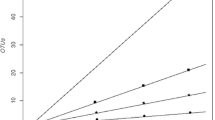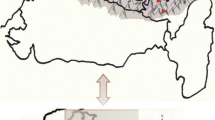Abstract
Acanthamoeba is a very abundant genus of soil protists with fundamental importance in nutrient cycling, but several strains can also act as human pathogens. The systematics of the genus is still unclear: currently 18 small-subunit (SSU or 18S) ribosomal RNA sequence types (T1–T18) are recognized, which sometimes contain several different morphotypes; on the other hand, some morphological identical strains belong to different sequence types, sometimes appearing in paraphyletic positions. In this study, we cultivated 65 Acanthamoeba clones from soil samples collected under grassland at three separate locations in the Netherlands, in Sardinia and at high altitude mountains in Tibet. We obtained 24 distinct partial sequences, which predominantly grouped within sequence type T4 followed by T2, T13, T16 and “OX-1” (in the T2/T6 clade). Our sequences were 98–99 % similar, but none was identical to already known Acanthamoeba sequences. The community composition of Acanthamoeba strains differed between locations, T4 being the dominant sequence type in Sardinia and Tibet, but represented only half of the clones from soils in the Netherlands. The other half of clones from the Dutch soils was made up by T2, T16 and “OX-1”, while T13 was only found in Sardinia and Tibet. None of the sequences was identical between localities. Several T4 clones from all three localities and all T13 clones grew at 37 °C while one T4 clone was highly cytopathogenic.

Similar content being viewed by others
References
Amaral-Zettler LA, Nerad TA, O'Kelly CJ, Peglar MT, Gillevet PM, Silberman JD, Sogin ML (2000) A molecular reassessment of the leptomyxid amoebae. Protist 151:275–282
Bagella S, Salis L, Marrosu GM, Rossetti I, Fanni S, Caria MC, Roggero PP (2013) Effects of long-term management practices on grassland plant assemblages in Mediterranean cork oak silvo-pastoral systems. Plant Ecol 214:621–631
Bonkowski M, Clarholm M (2012) Stimulation of plant growth through interactions of bacteria and protozoa: testing the auxiliary microbial loop hypothesis. Acta Protozool 51:237–247
Booton GC, Kelly DJ, Chu Y-W, Seal DV, Houang E, Lam DSC, Byers TJ, Fuerst PA (2002) 18S ribosomal DNA typing and tracking of Acanthamoeba species isolates from corneal scrape specimens, contact lenses, lens cases, and home water supplies of Acanthamoeba keratitis patients in Hong Kong. J Clin Microbiol 40:1621–1625
Cavalier-Smith T (1998) A revised six‐kingdom system of life. Biol Rev 73:203–266
Cavalier-Smith T, Chao EE (1995) The opalozoan Apusomonas is related to the common ancestor of animals, fungi, and choanoflagellates. Proc R Soc Lond B Biol Sci 261:1–6
Corsaro D, Venditti D (2010) Phylogenetic evidence for a new genotype of Acanthamoeba (Amoebozoa, Acanthamoebida). Parasitol Res 107:233–238
Corsaro D, Venditti D (2011) More Acanthamoeba genotypes: limits to the use rDNA fragments to describe new genotypes. Acta Protozool 50:49
Darriba D, Taboada GL, Doallo R, Posada D (2012) jModelTest 2: more models, new heuristics and parallel computing. Nat Methods 9:772
Dyková I, Lom J, Schroeder-Diedrich JM, Booton GC, Byers TJ (1999) Acanthamoeba strains isolated from organs of freshwater fishes. J Parasitol 85:1106–1113
Efron N, Young G, Brennan NA (1989) Ocular surface temperature. Curr Eye Res 8:901–906
Gast RJ, Ledee DR, Fuerst PA, Byers TJ (1996) Subgenus systematics of Acanthamoeba: four nuclear 18S rDNA sequence types. J Eukaryot Microbiol 43:498–504
Gouy M, Guindon S, Gascuel O (2010) SeaView version 4: a multiplatform graphical user interface for sequence alignment and phylogenetic tree building. Mol Biol Evol 27:221–224
Griffiths BS, Bonkowski M, Dobson G, Caul S (1999) Changes in soil microbial community structure in the presence of microbial-feeding nematodes and protozoa. Pedobiologia 43:297–304
Hedlund K, Santa Regina I, Van der Putten WH, Lepš J, Díaz T, Korthals GW, Lavorel S, Brown VK, Gormsen D, Mortimer SR, Rodríguez Barrueco C, Roy J, Smilauer P, Smilauerová M, Van Dijk C (2003) Plant species diversity, plant biomass and responses of the soil community on abandoned land across Europe: idiosyncracy or above–belowground time lags. Oikos 103:45–58
Heger TJ, Mitchell EAD, Leander BS (2013) Holarctic phylogeography of the testate amoeba Hyalosphenia papilio (Amoebozoa: Arcellinida) reveals extensive genetic diversity explained more by environment than dispersal limitation. Mol Ecol 22:5172–5184
Hewett MK, Robinson BS, Monis PT, Saint CP (2003) Identification of a new Acanthamoeba 18S rRNA gene sequence type, corresponding to the species Acanthamoeba jacobsi Sawyer, Nerad and Visvesvara, 1992 (Lobosea: Acanthamoebidae). Acta Protozool 42:325–329
Horn M, Fritsche TR, Gautom RK, Schleifer K-H, Wagner M (1999) Novel bacterial endosymbionts of Acanthamoeba spp. related to the Paramecium caudatum symbiont Caedibacter caryophilus. Environ Microbiol 1:357–367
Kreuzer K, Adamczyk J, Iijima M, Wagner M, Scheu S, Bonkowski M (2006) Grazing of a common species of soil protozoa (Acanthamoeba castellanii) affects rhizosphere bacterial community composition and root architecture of rice (Oryza sativa L.). Soil Biol Biochem 38:1665–1672
Łanocha N, Kosik-Bogacka D, Maciejewska A, Sawczuk M, Wilk A, Kuźna-Grygiel W (2009) The occurrence Acanthamoeba (free living amoeba) in environmental and respiratory samples in Poland. Acta Protozool 48:271–279
Lara E, Berney C, Ekelund F, Harms H, Chatzinotas A (2007) Molecular comparison of cultivable protozoa from a pristine and a polycyclic aromatic hydrocarbon polluted site. Soil Biol Biochem 39:139–148
Maciver SK, Asif M, Simmen MW, Lorenzo-Morales J (2013) A systematic analysis of Acanthamoeba genotype frequency correlated with source and pathogenicity: T4 is confirmed as a pathogen-rich genotype. Eur J Protistol 49:217–221
Nuprasert W, Putaporntip C, Pariyakanok L, Jongwutiwes S (2010) Identification of a novel T17 genotype of Acanthamoeba from environmental isolates and T10 genotype causing keratitis in Thailand. J Clin Microbiol 48:4636–4640
Page FC (1988) A new key to freshwater and soil gymnamoebae with instructions for culture. Freshwater Biological Association, Ambleside
Page FC, Siemensma FJ (1991) Nackte Rhizopoda und Heliozoea. Gustav Fischer Verlag, Stuttgart
Pawlowski J (2000) Introduction to the molecular systematics of Foraminifera. Micropaleontology 46:1–12
Pussard M, Pons R (1977) Morphologie de la paroi kystique et taxonomie du genre Acanthamoeba (Protozoa, Amoebida). Protistologica 13:557–598
Qvarnstrom Y, Nerad TA, Visvesvara GS (2013) Characterization of a new pathogenic Acanthamoeba species, A. byersi n. sp., isolated from a human with fatal amoebic encephalitis. J Eukaryot Microbiol 60:626–633
Risler A, Coupat-Goutaland B, Pélandakis M (2013) Genotyping and phylogenetic analysis of Acanthamoeba isolates associated with keratitis. Parasitol Res 112:3807–3816
Rodríguez-Zaragoza S (1994) Ecology of free-living amoebae. Crit Rev Microbiol 20:225–241
Rodriguez-Zaragoza S, Mayzlish E, Steinberger Y (2005) Vertical distribution of the free-living amoeba population in soil under desert shrubs in the Negev desert, Israel. Appl Environ Microbiol 71:2053–2060
Rønn R, McCaig AE, Griffiths BS, Prosser JI (2002) Impact of protozoan grazing on bacterial community structure in soil microcosms. Appl Environ Microbiol 68:6094–6105
Rosenberg K, Bertaux J, Krome K, Hartmann A, Scheu S, Bonkowski M (2009) Soil amoebae rapidly change bacterial community composition in the rhizosphere of Arabidopsis thaliana. ISME J 3:675–684
Sambrook J, Fritsch EF, Maniatis T (1989) Molecular cloning: A laboratory manual. 2nd ed Cold Spring Harbor Laboratory Press, New York
Sawyer TK, Griffin JL (1975) A proposed new family, Acanthamoebidae n. fam. (Order Amoebida), for certain cyst-forming filose amoebae. Trans Am Microsc Soc 94:93–98
Schuster FL (2002) Cultivation of pathogenic and opportunistic free-living amebas. Clin Microbiol Rev 15:342–354
Schuster FL, Visvesvara GS (2004) Free-living amoebae as opportunistic and non-opportunistic pathogens of humans and animals. Int J Parasitol 34:1001–1027
Smirnov AV, Brown S (2004) Guide to the methods of study and identification of soil gymnamoebae. Protistology 3:148–190
Smirnov AV, Chao E, Nassonova ES, Cavalier-Smith T (2011) A revised classification of naked lobose amoebae (Amoebozoa: Lobosa). Protist 162:545–570
Stothard DR, Schroeder-Diedrich JM, Awwad MH, Gast RJ, Ledee DR, Rodriguez-Zaragoza S, Dean CL, Fuerst PA, Byers TJ (1998) The evolutionary history of the genus Acanthamoeba and the identification of eight new 18S rRNA gene sequence types. J Eukaryot Microbiol 45:45–54
Vannini A, Bruni N, Tomassini A, Franceschini S, Vettraino AM (2013) Pyrosequencing of environmental soil samples reveals biodiversity of the Phytophthora resident community in chestnut forests. FEMS Microbiol Ecol 85:433–442
Walochnik J, Obwaller A, Aspöck H (2000) Correlations between morphological, molecular biological, and physiological characteristics in clinical and nonclinical isolates of Acanthamoeba spp. Appl Environ Microbiol 66:4408–4413
Acknowledgments
This work was supported by a research grant from the EU-project ‘EcoFINDERS’ No. 264465.
Author information
Authors and Affiliations
Corresponding author
Electronic supplementary material
Below is the link to the electronic supplementary material.
Supplementary Fig. 1
Phylogenetic analysis of Centramoebida based on 145 SSU sequences (all 18 described SSU types of Acanthamoeba represented) and 1,771 positions, with Balamuthia and Prothacanthamoeba as outgroups. Major clades and T4 are boxed. Only sequence types are named, while individual sequences were omitted for clarity, except for new sequences obtained in this study (in red). Support values >50 % (maximum likelihood, left) or >0.5 (posterior probability, right) are shown for branches leading to major clades. Filled circles represent full support in both analyses; boxes: clades of sequence types with bright boxes containing clones obtained in this study (JPEG 1116 kb)
Supplementary Fig. 2
Phylogenetic analysis focusing on sequence types and sequences associated with the new sequences obtained in this study. In total, 116 sequences with 1,947 unambiguously aligned positions were used; the tree is unrooted; values higher than 60 for maximum likelihood analyses (left) and 0.60 for Bayesian analyses (right) are shown. Black circles represent full support; red: strains obtained in this study; boxes: associated sequence types with bright boxes containing clones obtained in this study (JPEG 3408 kb)
Rights and permissions
About this article
Cite this article
Geisen, S., Fiore-Donno, A.M., Walochnik, J. et al. Acanthamoeba everywhere: high diversity of Acanthamoeba in soils. Parasitol Res 113, 3151–3158 (2014). https://doi.org/10.1007/s00436-014-3976-8
Received:
Accepted:
Published:
Issue Date:
DOI: https://doi.org/10.1007/s00436-014-3976-8




